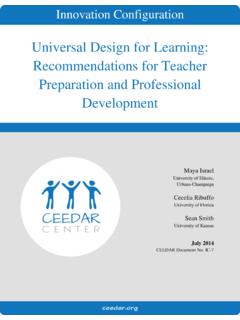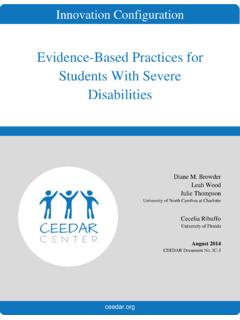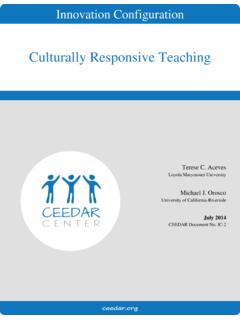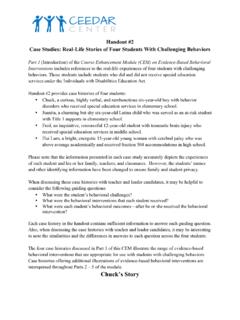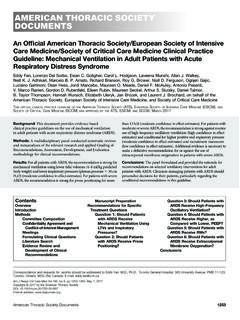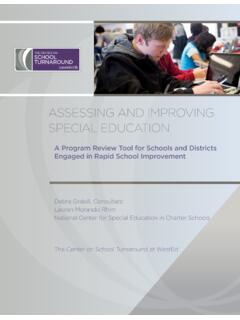Transcription of Evidence-Based Practices for English Learners - CEEDAR
1 Innovation ConfigurationEvidence- based Practices for English LearnersCara Richards-Tutor California State University, Long Beach Terese Aceves Loyola Marymount University Leslie Reese California State University, Long Beach November 2016 Page 2 of 84 Disclaimer: This content was produced under Department of Education, Office of Special Education Programs, Award No. H325A120003. Bonnie Jones and David Guardino serve as the project officers. The views expressed herein do not necessarily represent the positions or polices of the Department of Education. No official endorsement by the Department of Education of any product, commodity, service, or enterprise mentioned in this website is intended or should be inferred.
2 Recommended Citation: Richards-Tutor, C., Aceves, T., & Reese, L. (2016). Evidence-Based Practices for English Learners (Document No. IC-18). Retrieved from University of Florida, Collaboration for Effective Educator, Development, Accountability, and Reform Center website: Note: There are no copyright restrictions on this document; however, please use the proper citation above. Page 3 of 84 Table of Contents Innovation Configuration for Evidence-Based Practices for English Learners .. 5 Academic Instruction .. 7 Recommendation 1: Provide Students the Opportunity to Develop Academic Oral Language While Simultaneously Teaching Literacy and Other Content Areas .. 7 Recommendation 2: Teach Vocabulary Across Content Areas .. 11 Recommendation 3: Provide Instruction and/or Instructional Support in the Primary Language as Needed.
3 15 Recommendation 4: Provide Appropriate Interventions for English Learners Who Need Support Beyond Tier 1 Instruction .. 18 Recommendation 5: Implement Culturally Responsive Instruction (see Aceves & Orosco, 2014) .. 20 Progress 20 Recommendation 1: Implement Purposeful and Appropriate Assessment Practices Taking Into Account English Learners Primary Language, English -Language Proficiency, and Ongoing Linguistic and Academic Progress.. 21 Recommendation 2: Utilize Curriculum- based Measurement to Determine Risk and Monitor Progress Across Tiers With English Learners as Part of a School Site or District s Comprehensive MTSS Model .. 25 Recommendation 3: Employ an Ecological Approach When Evaluating English Learners Possible Learning Difficulties and to Develop Appropriate and Culturally Responsive Supports.
4 30 Family-School Partnerships .. 36 Page 4 of 84 Recommendation 1: Develop Parent Involvement Programs That Are Carried Out in the Home Language, Are Sustained Over Time, and Are Responsive to the Cultural Experiences of the Families.. 37 Recommendation 2: Understand the Out-of-School Experiences of Children and How These May Differ From the Skills Demonstrated at School.. 40 Recommendation 3: Provide Strategies for Parents of English Learners to Enhance the Effectiveness of Parent Involvement Activities .. 44 Conclusion .. 45 References .. 46 Appendix A: Innovation Configuration for Evidence-Based Practices for English Learners Academic Instruction .. 68 Appendix B: Levels of Support for Evidence-Based Practices for English Learners .. 76 Page 5 of 84 Innovation Configuration for Evidence-Based Practices for English Learners This paper features an innovation configuration (IC) matrix that can guide teacher preparation professionals in Evidence-Based Practices for English Learners .
5 This matrix appears in Appendix A. An IC is a tool that identifies and describes the major components of a practice or innovation. With the implementation of any innovation comes a continuum of configurations of implementation from non-use to the ideal. ICs are organized around two dimensions: essential components and degree of implementation (Hall & Hord, 1987; Roy & Hord, 2004). Essential components of the IC along with descriptors and examples to guide application of the criteria to course work, standards, and classroom Practices are listed in the rows of the far left column of the matrix. Several levels of implementation are defined in the top row of the matrix. For example, no mention of the essential component is the lowest level of implementation and would receive a score of zero.
6 Increasing levels of implementation receive progressively higher scores. ICs have been used in the development and implementation of educational innovations for at least 30 years (Hall & Hord, 2001; Hall, Loucks, Rutherford, & Newton, 1975; Hord, Rutherford, Huling-Austin, & Hall, 1987; Roy & Hord, 2004). Experts studying educational change in a national research center originally developed these tools, which are used for professional development (PD) in the Concerns- based Adoption Model (CBAM). The tools have also been used for program evaluation (Hall & Hord, 2001; Roy & Hord, 2004). Use of this tool to evaluate course syllabi can help teacher preparation leaders ensure that they emphasize proactive, preventative approaches instead of exclusive reliance on behavior reduction strategies.
7 The IC included in Appendix A of this paper is designed for teacher preparation programs, although it can be modified as an observation tool for PD purposes. The Collaboration for Effective Educator, Development, Accountability, and Reform ( CEEDAR ) Center ICs are extensions of the seven ICs originally created by the National Comprehensive Center for Teacher Quality (NCCTQ). NCCTQ professionals wrote the above description. Page 6 of 84 This innovation configuration (IC) identifies effective Practices for English Learners (ELs) within a multi-tiered system of supports (MTSS) framework. In this IC, we have defined Tier 1 as core instruction, Tier 2 as a small-group strategic intervention for students who are struggling, and Tier 3 as intensive intervention for students with significant and persistent needs.
8 To determine the effective Practices for K-8 ELs, we conducted literature searches for each area using PsychInfo, Academic Search Complete, and ERIC. We searched the terms English Learners , English language Learners , second language Learners , and language minority students for each of the three focus areas: (a) academic instruction, (b) progress monitoring, and (c) family-school partnerships. We summarized effective Practices from peer -reviewed literature published between 2005 and 2015. We reviewed empirical work with and without student outcome measures ( , empirical work that focused on teachers) as well as non-empirical work ( , reviews of the literature, book chapters, Institute of Education Services [IES] practice guides) when the work reported the results of empirical findings of others.
9 We did not include textbooks and articles that provided teaching recommendations and activities without specifying and describing the empirical rationale for the recommendations. We automatically included empirical studies that included only EL participants; we included the data if an empirical study included ELs and non-ELs and the data for the ELs were disaggregated. The Practices for ELs are divided into three categories: (a) academic instruction, (b) monitoring of student progress, and (c) family-school partnerships. Many of the overarching recommendations are not different from what would be recommended for students who are not ELs. However, the sub-recommendations are essential for ELs. The sub-recommendations may be different from what works for non-ELs or may not be necessary for these students.
10 These recommendations are not just good teaching but are critical for positive outcomes for ELs. For Page 7 of 84 each sub-recommendation, we have indicated the tier or tiers that we recommend for practice. In a few cases, we have recommended the practice at tiers where there is not evidence from the literature, but implementing the practice for ELs across tiers ( , provide audio versions of books and vocabulary to be used at home) would make sense. Finally, we want to note that many of the recommended Practices should be applied in conjunction with other Practices rather than considered in isolation. Academic Instruction The purpose of this section of the IC was to provide recommendations for effective Practices and strategies for academic instruction for ELs.

